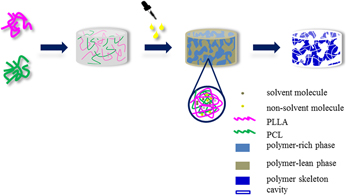Crossref Citations
This article has been cited by the following publications. This list is generated based on data provided by
Crossref.
Zhang, Xin
Zhang, Xianwen
and
Wang, Chongmin
2019.
Building advanced materials via particle aggregation and molecular self-assembly.
Journal of Materials Research,
Vol. 34,
Issue. 17,
p.
2911.
Delgado-Rangel, Luis Humberto
Huerta-Saquero, Alejandro
Eufracio-García, Nancy
Meza-Villezcas, Anaid
Mota-Morales, Josué D.
and
González-Campos, J. Betzabe
2020.
Deep eutectic solvent-assisted phase separation in chitosan solutions for the production of 3D monoliths and films with tailored porosities.
International Journal of Biological Macromolecules,
Vol. 164,
Issue. ,
p.
4084.
Ge, Xin
Chang, Mingming
Jiang, Wei
Zhang, Bangwen
Xing, Ruiguang
and
Bulin, Chaoke
2020.
Selective location of kaolin and effects of maleic anhydride in kaolin/poly(ε-caprolactone)/poly(lactic acid) composites.
Applied Clay Science,
Vol. 189,
Issue. ,
p.
105524.
Jiang, Wei
Ge, Xin
Zhang, Bangwen
Xing, Ruiguang
and
Chang, Mingming
2020.
Different Influences of Two Peroxide Initiators on Structure and Properties of Poly(Lactic Acid).
Journal of Vinyl and Additive Technology,
Vol. 26,
Issue. 4,
p.
452.
Ge, Xin
Chang, Mingming
Jiang, Wei
Zhang, Bangwen
Xing, Ruiguang
and
Bulin, Chaoke
2020.
Investigation on two modification strategies for the reinforcement of biodegradable lignin/poly(lactic acid) blends.
Journal of Applied Polymer Science,
Vol. 137,
Issue. 44,
Shu, You
Luo, Qionglin
Wang, Mingliang
Ouyang, Yuejun
Lin, Hongwei
Sheng, Liping
and
Su, Shengpei
2021.
Preparation and properties of poly(lactic acid)/lignin‐modified polyvinyl acetate composites.
Journal of Applied Polymer Science,
Vol. 138,
Issue. 7,
Chen, Mingjing
Uyama, Hiroshi
Wang, Xinhou
and
Sun, Xiaoxia
2023.
A green and facile approach to prepare polylactide/kapok monoliths for a sustainable and reusable oil sorbent.
Colloid and Polymer Science,
Vol. 301,
Issue. 10,
p.
1261.
Qian, Chenghui
Liu, Yubo
Chen, Si
Zhang, Chenyang
Chen, Xiaohong
Liu, Yuehua
and
Liu, Ping
2023.
Electrospun core–sheath PCL nanofibers loaded with nHA and simvastatin and their potential bone regeneration applications.
Frontiers in Bioengineering and Biotechnology,
Vol. 11,
Issue. ,
Rafiq, Hasinah
Hsu, Yu-I
and
Uyama, Hiroshi
2024.
Preparation of nanoporous poly (L-lactic acid) microspheres with controllable morphology via thermally-induced phase separation.
Polymer,
Vol. 312,
Issue. ,
p.
127622.
